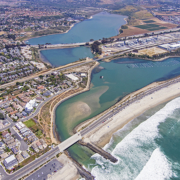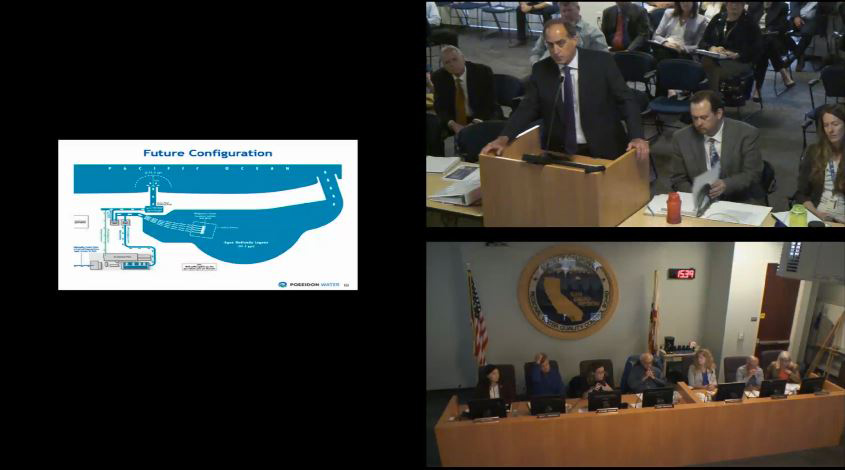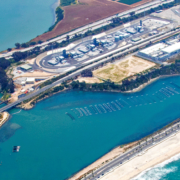Poseidon Water, a national leader in the development of water supply and treatment projects using a public-private partnership approach, furthered its commitment to protect and preserve San Diego’s coastal environment by assuming stewardship of the Agua Hedionda Lagoon in Carlsbad.
The Agua Hedionda Lagoon encompasses over 400 acres of marine, estuarine and wetlands habitat teeming with hundreds of fish, invertebrate and bird species. The lagoon has long been home to youth recreation activities, including the YMCA Aquatic Park (affectionately known to its patrons as “Camp H2O”), as well as popular activities for visitors of all ages, such as kayaking, swimming, canoeing and paddle-boarding. As the lagoon’s steward, Poseidon Water is taking responsibility for ensuring the man-made lagoon continues to realize the life-sustaining benefits of an open connection to the Pacific Ocean.
Maintaining healthy marine ecosystem
Poseidon Water is ensuring the ongoing vitality of this magnificent estuary through periodic maintenance dredging. Dredging keeps sand from blocking the flow of ocean water in and out of the lagoon, maintaining its tidal circulation, which is needed to maintain a healthy marine ecosystem, support extensive recreational uses, sustainable aquaculture (Carlsbad Aquafarm) and a white seabass fish hatchery (Hubbs-SeaWorld Fish Hatchery). Dredging also helps replenish the sand on Carlsbad State Beach, which otherwise would revert to historical cobble-stone, with sand that is relocated from the lagoon to nearby shoreline, ensuring the local beaches are attractive for local residents and visitors to enjoy.
“The Agua Hedionda Lagoon Foundation has been dedicated to providing direct access to nature while ensuring the environmental protection of the lagoon,” said Lisa Cannon-Rodman, chief executive officer of the Agua Hedionda Lagoon Foundation. “We are thrilled that Poseidon Water will continue in these efforts and can confidently say that the community will continue to experience the splendor of this unique environment for many years to come.”
Unique lagoon environment
Some of the uses that make up this unique environment include:
1. Man-Made Marine Estuary – Aqua Hedionda Lagoon is a man-made estuary consisting of 400 acres of inter-tidal wetlands and uplands that are home to a wide variety of fish, invertebrates, animals and birds.
2. Claude “Bud” Lewis Carlsbad Desalination Plant – The Carlsbad Desalination Plant produces over 50 million gallons of high-quality and climate-resilient drinking water each day, serving approximately 10 percent of the region’s water demand.
3. YMCA Aquatic Park – The YMCA Aquatic Park, better known as Camp H2O, is a summer camp geared towards children ages seven to twelve that offers affordable day camp activities including swimming, kayaking, boating and fishing. The camp plays an important role in educating youth about the precious marine environment and the need to preserve the lagoon for future generations.
4. Hubbs-SeaWorld Fish Hatchery – Hubbs-SeaWorld Resources Enhancement and Hatchery Program include a 22,000 square-foot fish hatchery on the lagoon. The Program actively contributes to the restoration of the California white seabass population, adding over 350,000 juveniles annually. Hubbs-SeaWorld has begun to expand its marine restoration activities as a result of additional acreage donated by the Desalination Plant.
5. Recreational Boating – Boating remains one of the most popular lagoon activities for residents and visitors alike. California Water Sports offers expert lessons and rents a variety of boats, including kayaks, canoes and paddleboards to the public.
6. Carlsbad Aquafarm – The lagoon is home to the Carlsbad Aquafarm, Southern California’s only shellfish aquafarm, where over 1.5 million pounds of shellfish are sustainably harvested each year. The farm is a growing contributor to the $1.5 billion U.S. aquafarming industry and the San Diego region’s local economy.
7. Agua Hedionda Lagoon Foundation Discovery Center – Opened in 2006, the Discovery Center offers visitors an opportunity to learn about the lagoon’s native plants and marine life through exhibits and educational programs and hosts more than 8,700 local students each year.
Lagoon preservation
“Agua Hedionda Lagoon plays a key role not just in our environment, but also Carlsbad’s quality of life and economy,” said City of Carlsbad Mayor Matt Hall. “By ensuring the lagoon’s long-term preservation, Poseidon Water has once again demonstrated its commitment to Carlsbad and environmental sustainability.”
The Lagoon was previously maintained by NRG, owner of the now decommissioned Encina Power Station. The Carlsbad Desalination Plant is located on the same site as the Encina Power Station and utilizes the power plant’s historic intake and outfall facilities for the desalination process. As part of its co-location, Poseidon Water has long planned to succeed NRG as the lagoon’s steward.
With the decommissioning of Encina Power Station, the Carlsbad Desalination Plant is modernizing the existing intake facilities to provide include additional environmental enhancements to protect and preserve the marine environment.
“Our location along the shore of the Agua Hedionda Lagoon makes it a critical part of the Carlsbad Desalination Plant’s operations, which enables us to provide San Diego County with more than 50 million gallons of high-quality drinking water every day,” said Carlos Riva, Poseidon Water CEO. “We look forward to taking an even more active role in the protection and preservation of the lagoon so that we can all enjoy its recreational and marine resources now and for generations to come.”
Assuming responsibility for the lagoon is just the latest in Poseidon Water’s long history of environmental stewardship in California, by employing 100 percent carbon neutral desalination technology at its Carlsbad Desalination Plant – making it the first major infrastructure project in California to eliminate its carbon footprint – and committing to do the same at its proposed Huntington Beach Seawater Desalination Plant. These efforts continue to assist communities in becoming water independent and less susceptible to dangerous drought conditions, without any carbon emissions.





